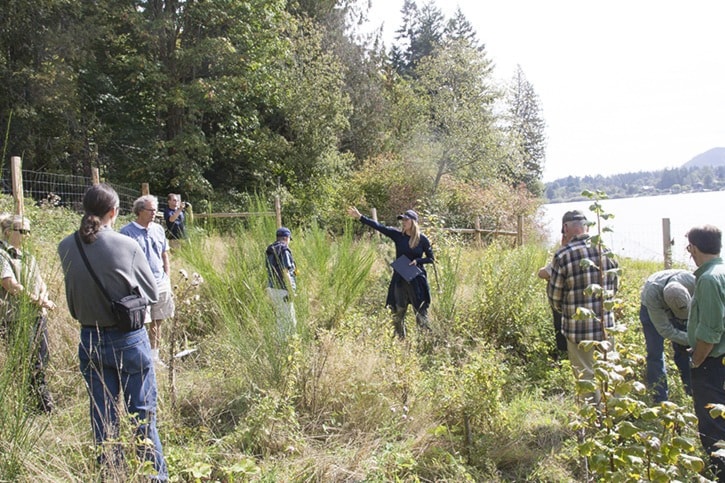Riparian zones — those important buffers between land and water found all around Cowichan Lake and alongside the many creeks and rivers in this area — are under threat, and it’s only getting worse.
That was one of the take-aways from a recent tour of riparian zones, hosted by the Cowichan Lake and River Stewardship Society.
On Friday, close to 20 nature enthusiasts, professionals and property owners participated in CLRSS’s latest tour, which involved visiting multiple sections of the Cowichan Lake shoreline to see how riparian zones are being restored or protected from developments.
“It’s to demonstrate how exactly we are doing this riparian restoration and all the benefits that surround it. All the challenges that surround it,” said Christine Brophy, project manager of the CLRSS Shoreline Stewardship Program. “We’re informing all property owners, media, our funders, all interested professionals (whether it’s CVRD planners, restoration specialists) anyone that’s interested or working in and around the riparian area.”
The tour started at a lakeside property in Youbou before moving into the Lake Cowichan First Nation waterfront property that will be the future site of the Ts’uubaa-asatx Cafe, on North Shore Road.
Prior to 2013, when the Cowichan Shoreline Stewardship Program began restoring this property, it was inhabited almost entirely by Himalayan blackberry plants. This is the program’s largest riparian restoration site at close to 800 square metres. The blackberries were removed and 803 plants were put in there during a one-day planting party that involved a five-person crew from the shoreline stewardship program and over 50 volunteers.
This year, red osier dogwood and Scouler’s willow were live-staked on the site to increase plant density. LCFN plans to include trails on the site along with interpretative signage explaining the importance of healthy riparian areas.
The tour then visited a vacant lot in downtown Lake Cowichan, next door to the municipal office, where Brophy and her team have been restoring the foreshore between the town-owned property and the river below where Himalayan blackberry had taken over 90 per cent of the riparian area.
Restorations like these require constant care to prevent invasive species from returning and to remove any newcomers that appear year to year. Brophy frequently works with property owners to help develop a plan to maintain healthy riparian areas.
“Education is key,” she said. “The more people are informed and educated and that’s already in their heart, I think that’s not an issue… There’s also the people that are basically against it because it means that they can’t do whatever they want on the foreshore. And they’re the biggest challenge. And they’re the people whose mindset we really need to focus on because they’re the ones doing all the damage.”
A shortage of enforcement officers is one of the biggest challenges facing riparian zones, according to Brophy, and the only way that will change is if governments take notice and provide more funding for those positions.
“Our conservation officer here, he always has to attend public safety calls first so [if] there’s a bear, there’s a cougar... He’s dealing with stuff like meth labs in the woods. So riparian areas literally get dropped to the bottom of the list,” she said. “How do you get more… enforcement so they’re not spread so thin? We just need more people.”
Brophy said that Lake area residents and property owners are aware of this shortage and take full advantage.
“It’s really common and I’d say it’s getting worse,” she said.
Genevieve Singleton, co-chair of the Cowichan Stewardship Roundtable and one of the tour’s participants, said she was impressed with the activity.
“We got to see a variety of different types of sites facing a variety of issues,” she said. Whether or not someone has riparian property themselves, Singleton said “spreading the gospel in general that revegetation along creeks [and] lakes is super important to protect our fish and our precious ecosystem in general.”
